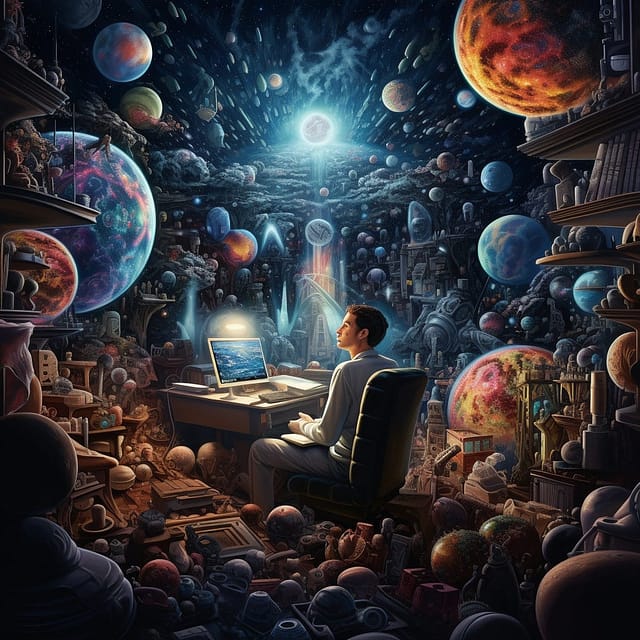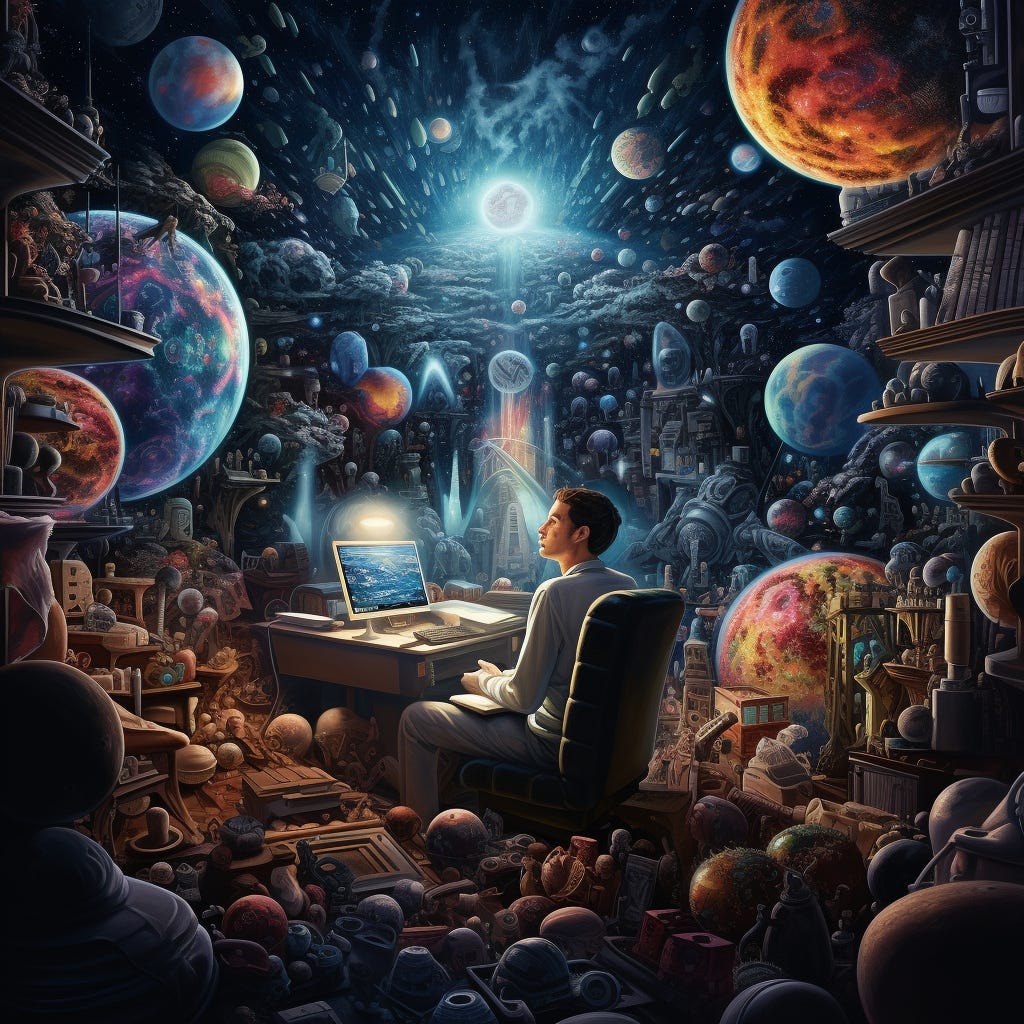
Synchronicity
How Silicon Valley has Commodified Jung, Part 1
My living room blinds were twisted half-way open for the sake of our houseplants, so I happened to catch the first bubble peripherally while working on the couch. I looked up with amused curiosity just in time for the second confusing bubble to bumble by.
It was pretty fuckin’ whimsical.
Walking outside, I was unable to find the bubbles’ source. Faced with the incomprehensibility of the coincidence, I simply had to thank the Universe.
I’d just finished writing my second ever essay for the original Creekmasons blog. Becoming an essayist had seemed like an unlikely expression of my writing obsession for a long time. I remember the class’s dismay when my high school English teacher told us she wrote essays in her spare time “for fun.” Struck with a tweaky, artificial compulsion toward cool, authentic nonchalance—as if those classmates whose approval I desperately clowned to acquire might ever change their opinion of me—I stuck to fiction and poetry for years.
Is poetry not cool? Maybe you’re not emo enough.
No, you’re right. It’s not cool.
But! I had just finished the second essay of my adult life, itself a sort of emo love song. Although it articulated my own invented metaphysical beliefs, it was primarily an olive branch extended toward my wife after a challenging week. I readily accepted the bubbles that mysteriously floated down my street—a pair of them—as a sign from the universe because that essay was an ode to my wife’s love of bubbles.
Carl Jung called this phenomenon “Synchronicity.” He defined that term as the “acausal connecting principle” that often seems to indicate a relationship between totally unrelated events or experiences. The anecdote he famously relied on to explain the principle was a true fish story.
“On April 1, 1949, I made a note in the morning of an inscription containing a figure that was half man and half fish. There was fish for lunch. Somebody mentioned the custom of making an “April fish” of someone. In the afternoon, a former patient of mine, whom I had not seen for months, showed me some impressive pictures of fish. In the evening, I was shown a piece of embroidery with sea monsters and fishes in it. The next morning, I saw a former patient, who was visiting me for the first time in ten years. She had dreamed of a large fish the night before. A few months later, when I was using this series for a larger work and had just finished writing it down, I walked over to a spot by the lake in front of the house, where I had already been several times that morning. This time a fish a foot long lay on the sea-wall. Since no one else was present, I have no idea how the fish could have got there.”
Carl Jung, Synchronicity: An Acausal Connecting Principle
Jung is everywhere lately…
Have you noticed that?
Jungian mysticism and psychology pervade my TikTok “For You Page.” Metamodern thinkers camp at every digital streetcorner soapboxing about archetypes and shadow work.
Why?
Our path to an answer requires some background.
Marshall McLuhan coined the phrase, “The medium is the message,” to describe the impact on our collective psychology that different communications technologies engender simply through the way they structure our interactions with them.
We tend to focus on the content of our media when we consider what effect it has on society. Smutty TV and violent videogames were repeatedly accused of corrupting my generation. Through the ideas our entertainment promoted, we were supposedly encouraged to be crass, vulgar and dangerous.
Arguments could be made in either direction there, really. But instead, let’s focus on this “medium is the message” mechanism through which Jungian content is popping back up in the popular modern discourse.
An important effect of mass media like television was that we developed a culture that prioritized everyone living in the same narrative reality. Particularly when there were only a few channels, TV promoted groupthink and passive consumption. Numb zombies staring at a screen were receptive to their consent being manufactured by reporters, because they were sitting still and absorbing the TV’s glowing pictures and attention grabbing sounds.
The invention of videogames has helped inspire a cultural shift as well. Now that the entertained can interact with their entertainment, a sense of agency has developed. The joystick may be partially responsible for the LARP that was the January 6th riots in that it allowed a generation or two to inhabit the supremely Good role of savior in their videogames, helping them believe they could take action to affect world affairs with extra-lives-inspired invulnerable impunity.
Subscribed
So what does this have to do with Jung?
It is well known by this point that our social media algorithms operate by bucketing us into demographics that behave and believe similarly, then subtly nudge our behavior toward even more deeply embodying those characteristics.
This is the business model of what Shoshanna Zuboff called Surveillance Capitalism: search engines and social media companies don’t make money through ads so much as through “behavioral futures.” They make money by predicting what we’re going to do, and by ensuring they’re right in their predictions through psychological manipulation. They sell these behavioral predictions—or perhaps “behavioral persuasion” is the better phrase—to companies that turn a profit from them.
Now, the same way that Adam Curtis identified that Frued’s nephew, Edward Bernays, was able to drive the 20th century culture with his uncle’s ideas, modern technologists are relying—whether they realize it or not—on Jungian concepts to power their tools.
And in the process, they’re creating a new zeitgeist of interest in Jung. Jung seems to gain increasing explanatory power over reality because we interact with his philosophy every time we open an app that operates via algorithm.
Examples?
- When you listen to the methods of Cambridge Analytica, it almost sounds like they’re talking about marketing politicians differently to different astrological signs. Or perhaps more accurately, to personality types first pioneered by Jung through the project of identifying archetypes.
- These algorithms are constantly inviting us to confront our own shadows. The shadow is composed of the characteristics of ourselves that we feel so much aversion towards that we are generally unwilling to even admit we possess them. These are the same sticky emotions, like jealousy, anger and fear, that algorithms use to keep us scrolling and sharing. Some platforms become, for some users, outrage factories that force them to confront aspects of their own humanity that they’d rather deny, often in the form of purposefully inflammatory posts from outright bots.
- As a last example, take the subject I touched on earlier, Synchronicity. I’ll say a few words about synchronicity here as the first part in a multipart series—that will cover the two items above as well—about the commercial degradation of Jungian psychology and mysticism that I am calling Commodified Jung.

Synchronicity
The difference between meaningful synchronicity and meaningless coincidence is simply the mental energy spent bathing in wonder over the improbability of the event.
Our brains were built to recognize patterns. Understanding the underlying patterns governing how our prey migrated and where they grazed kept our ancestors well-fed. Reading the weather from a sniff of the air or the presence of a predator from the lichen unevenly scuffed across a river stone kept them safe.
So we get a hit of dopamine when we uncover a hidden connection between apparently unrelated events. This is our brain’s way of trying to motivate us to seek more patterns; a reward for our attentiveness and spur toward further exploration.
You’re welcome to an explanation of synchronicity that relies on ripples reverberating through a fabric of consciousness connecting every thing in the universe and changing things locally when there is action at a distance. In fact I wholeheartedly endorse playing with that level of woo. Sometimes I’m swayed by it myself.
Still, this other explanation is accessible.
This dopamine mechanism doesn’t only reward pattern recognition. It encourages it. With dopamine flooding the brain, neurons that aren’t wired together can still be encouraged to fire together. Literally forming connections between unrelated concepts.
Algorithm driven social media apps hijack this dopamine circuitry in order to achieve their target metrics of “stickiness” and behavioral modification.
An app like Twitter, TikTok or Instagram operates like a slot machine. There is an optimal pattern at which awards arrive that keeps the gambler, or scroller, glued to the screen. This metaphor is literal: Facebook pioneered this by encouraging their Product Managers to read manuals on casino design in order to inspire features that would increase the amount of time users spend on the site.
Too much dopamine too consistently, and we get habituated; too little and we aren’t compelled to stick around. But just the right amount delivered at inconsistent intervals has our subconscious occupied trying to discern the pattern.
All the typical dopamine mechanisms, like sex and humor, are employed of course, but—at least in my personal observation—there’s also a constant string of synchronicities delivered by algorithm-recommended content.
For example, say that over a smoke break you’re telling your coworkers about how much you value mental health. Open your phone to Google some innocuous phrase a little later and all the results are blog entries from Psychology Today. You’re shopping a bit later and all the advertisements on Amazon are for Better Help. The content shoveled into your social media feed features self-help and wellness influencers.
It sounds a bit like Jung’s story about the fish copied above, doesn’t it?
Synchronicities’ with a message
Why did I feel so grateful for the pair of inexplicable bubbles that I began this essay with? Why not just chalk them up to a simple, if amusing, coincidence and end it at that?
Because I’ve been radicalized into the woo by Midnight Gospel creator and warm-hearted podcaster, Duncan Trussell.
I enjoy Trussell’s take because it lends meaning to life. He illustrates it with a story of his guru, Ram Dass, paddling out into the Maui ocean on a floatie and—apparently magically—transmuting the weather from summer storm downpour to a sunny sky adorned with an enormous, vivid rainbow.
The point of synchronicities, Trussell says, is to let you know that you’re on the right track, just as he was in hanging out with Ram Dass. Just as Ram Dass was via his dedication to Yogic enlightenment.
When you’re acting in alignment with your highest good, behaving authentically as your true self, and working to achieve a meaningful purpose, the synchronicities genuinely do seem to spring up more often.
Maybe that’s a function of your brain—lit up with success and fulfillment—bathing in dopamine. Or maybe dopamine is just the material expression and the true cause is a “radio wave” from the ubiquitous field of pure, conscious Soul wiggling a sense of attunement through your incarnation’s present moment.
Either way, it feels natural, intuitive, even instinctive, to infer a simple message from every string of synchronicities: keep going!
With that in mind, isn’t it obvious why our corporate overlords have so often employed algorithms that utilize our data to produce causal versions of Jung’s “acausal connecting principles”? Am I meant to consider myself “on the right track” when the same ad for mattresses pops up for the umpteenth time?
It is frequently reported that social media designers don’t fully understand the logic that governs the machine learning generated algorithms that they produce. They give their programs a desired outcome and let the machine figure out the best way to achieve it. So, saddling Jung’s philosophy in service of selling commodities might actually be the computers’ idea.
It might be the algorithms themselves that have identified the validity of Jung’s analysis. In the case of synchronicity, they may have uncovered the instinctive drive we have to be spurred along our path by meaningful-seeming coincidence.
The subsequent parts of this essay series on how Silicon Valley has commodified Jung’s philosophy will be more actionable: I’ll talk about using social media as shadow work to generate lovingkindess for yourself and others; I’ll explore algorithmic archetypes in service of engaging your individual agency to deliberately craft an identity that’s an authentic vibe for your True Self.
For now, social media companies attempting to manipulate us to become more predictable consumers with causal connecting principles simply underscores the necessity of reveling in the acausal, in becoming unpredictable and therefore ungovernable.
It drives home the necessity of seeking our own meaning.

Geoff Gallinger writes poems, essays and fiction and has said a time or two that a Bachelor’s in Creative Writing from SF State qualifies them perfectly for being a pizza driver. That sounds like self-deprecation, but hours a day completely alone in a beater car with an audiobook and a notepad for company are actually a good approximation of a “room of one’s own.”
Being home isn’t too bad either; their daughter and wife will always be their primary audience.